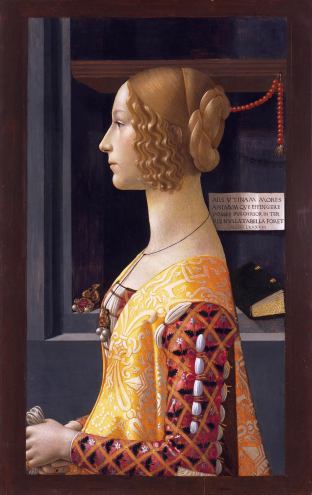- “Mona Lisa” by Leonardo DaVinci
- “Giovanna Tornabuoni” by Domenico Ghirlandaio
The year is 2001; the backdrop, a college art history class. I’m on the edge of my chair. My professor is talking about the Mona Lisa, perhaps the world’s most famous painting.
It is here that we can pause and consider why the story of art is as important as the image itself. When Leonardo painted this portrait, portraits were largely commissioned to show one’s wealth and position, as in Ghirlandaio’s portrait of Giovanna Tornabuoni. Notice that Giovanna is not facing us; she is certainly not looking right into our eyes as the Mona Lisa is. The backdrop is indoors, featuring her jewelry (highlighting her wealth) and a book (signifying that she is educated), as well as a quote from the ancient Roman poet Martial (to show that she’s cultured).
So Mona was a first in many ways. It is the firsts that show up in art history. Mona is not only looking right at us, boldly, but she is in simple clothes, outside (gasp!) and there is nothing that tells of her position. Instead, Leonardo focuses on the person. Though there is some debate as to who this person is, she is widely believed to be Maria Gherardini, the wife of a wealthy Florentine. Yet, all we see is the person.
Leonardo also used lights and darks to create a more dramatic effect (chiaroscuro) and invented sfumato, a misty haziness. This is believed to be the reason we cannot tell where Mona is looking and whether she is smiling. Leonardo was said to have loved the painting so much that he never gave it to the patron and it was found among his possessions when he died.
To me, these things made this very familiar painting come alive. Now I see what the “big deal” is and why she is so famous. Doing what everyone else was doing never landed anyone in an art history book. It’s a good reminder for all of us to think outside the box. and also, an inspiration to learn the background of art. Artists are always responding to their life and times. It’s why I disagree with those who say that art should speak for itself and not need an explanation. It is in the explanation that we learn what an artist is thinking of, what they are responding to.
It is why for me, personally, as a landscape painter, that I want to learn as much about my subject as possible before I paint it. The story is the meaning as much as your response to the art is. Then you can bring your own story to a work of art. What does it make you feel?
As always, I love to hear from you. Do you have a story of a great work of art that moves you? What’s your story?
Let’s keep the conversation going on Facebook and Instagram where you can find me checking in on most days.
Cheers!










Mona was in DC in 1970. So was I. I was 17 and wondering around the museum. I got turned around and went through a door that I should not have. I walk passed this small picture as I was looking for my way out. The eyes of the picture followed me. I stopped, stared and was shocked to be up close, alone with Mona. I will never forget the experience. It could be because I was escorted out of a closed exhibit, or maybe because Mona smiled at me!
Mary, I absolutely LOVE that story! Wow. Your one of the few to ever have her to yourself for a few moments. I think it was the gaze and the smile?